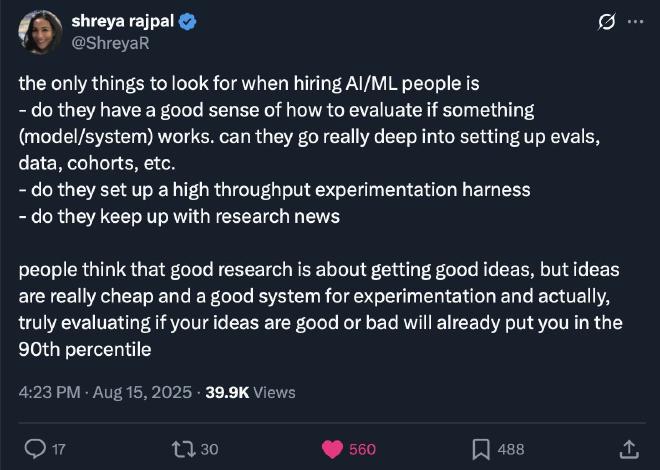The Core Qualities of a Great AI/ML Scientist- Beyond the Tools

Table of Contents
A recent tweet by Shreya Rajpal sparked a great conversation about what to look for in AI/ML talent, emphasizing systems for evaluation and experimentation. It’s a crucial point, especially for building teams that can iterate quickly. But it also got me thinking about the deeper qualities that I’ve seen in the truly exceptional AI/ML scientists I’ve had the privilege to work with.

Frameworks, libraries, and programming languages are just tools. They can be learned. The underlying hardware of a great mind, however, is much rarer and harder to build. I believe it comes down to three core, almost innate, qualities.
1. The Ability to See the Essence #
The most impactful scientists I know have a unique ability to cut through the noise. They can take a complex, loosely-defined problem, distill it down to its absolute essence, extract the core value, and define the problem worth attacking.
This deep thinking allows them to focus their energy—and help other team members focus theirs—on what truly matters. Instead of running ill-posed experiments, they design a handful of critical ones that strike at the heart of the problem. They aren’t trying to please stakeholders or follow the latest trends; they are driven by the fundamental question: “What is the principle I need to understand here?”. This often means holding a contrary opinion, arguing, and fighting for a deeper understanding.
2. The Rigor to Test and Harvest Truth #
An idea is just a starting point. The second quality is the discipline to properly test a hypothesis and the skill to do it at scale. There is nothing worse than doing excellent and extensive work on something that ultimately doesn’t matter.
It involves:
- Designing clean experiments: Isolating the real essence of the problem, defining its core, and identifying the factors that would lead to accepting or rejecting the hypothesis.
- Evaluating at scale: Building an experimentation system to iterate quickly—starting small to gain insights and then gradually scaling up.
- Harvesting results: Once the data is in, they can dig into it, separating the genuine signal from the noise, and extracting the core insight.
This loop—hypothesize, test, analyze, repeat—is the engine of progress, and great scientists are masters of navigating it with both speed and precision.
3. The Vision to Connect the Dots #
The third, and perhaps most elusive, quality is the ability to synthesize. Breakthroughs often don’t come from a single, linear path of inquiry. They come from connecting disparate ideas from seemingly unrelated fields.
A great researcher might take a concept from computational biology, an insight from a classic physics paper, and a technique from older machine learning papers, and see a novel way to combine them. This “polymath” tendency is a creative superpower, allowing them to see underlying patterns that connect different domains of knowledge and weave them into something entirely new.
Tools Are Temporary, Traits Are Foundational #
We spend a lot of time talking about the latest frameworks and models. But these are ephemeral. What truly sets the best apart are these foundational human qualities: the depth to find the essence, the rigor to test it, and the vision to connect it with the rest of the world’s knowledge.
This fundamentally different way of thinking is difficult to acquire. Some people have it, and others do not. When building a team, I’ve learned that it’s these traits, not a list of technologies on a resume, that are the true indicators of a scientist who will drive genuine innovation.